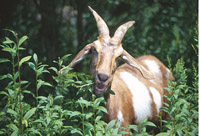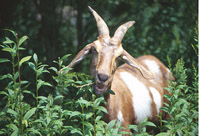
On the use and the dangers of Qat [Archives:2007/1035/Last Page]
March 22 2007
 |
For Yemen Times
It is said that Catha Edulis Forsk (more commonly known as Qat) was introduced to Yemen when Ethiopian sheep were brought to the country many years ago. In Ethiopia the sheep ate the leaves from the numerous Qat trees and grew into energetic and boisterous animals. When they moved to Yemen they appeared to lack the vitality that they had had across the Red Sea. Qat was imported and cultivated to rectify the situation, and a curious Yemeni farmer decided to sample the cuisine of the Ethiopian “super-sheep”. Thus Qat became a delicacy in Yemen.
What has this got to do with an article entitled “On the use and the dangers of Qat” the reader may well be asking himself. To begin we must consider the methods of digestion employed by sheep. The most striking thing about a sheep's eating habits- indeed about a whole host of domesticated herbivores)is that they chew. Their saliva is the first step in the digestion of tough green matter. If we cast a glance to the Yemeni's strewn in doorways, on floors, and even in wheelbarrows every afternoon throughout Yemen, we will see a distinctly similar chewing motion- Therefore we can conclude; for the full effects of Qat to be felt it must be reduced to its component parts in the users mouth, before it can be digested.
Now the reader is aware of how to gain frivolous kicks from the Qat leaf, the writer feels it is his moral duty to inform him of the nefarious elements involved with its consumption. That Qat is both addictive and detrimental to health are well-known arguments of the anti-Qat lobby. What is less well known are the dangers arising from the concentration of Qat's narcotic properties: I have endeavoured to undertake an oral investigation of these dangers frequently, and have it from envisioned sources that there are criminal gangs operating throughout the Horn of Africa and Yemen, who aren't able to make a most heinous chemical form the Qat leaf. A chemical 100 times stronger and more addictive than its parent! Ladies steal yourselves, gentleman do let go of that flow of righteous indignation pursed on your lips- there is worse to come! What I am about to recount will surely shock even the most hardened reader.
All that is needed to produce the chemical is the biological reduction of the Qat leaf in large quantities. The most successful catalyst for the breakdown is the saliva from a fresh sheep gland: the result is an extremely dangerous concentrated green powder. It isn't estimated that up to 25% of the sheep population of Ethiopia and Somalia are dry mouthed, as gangs rip out the saliva glands of innocent sheep in night raids to produce Dog (the street name of the new drug). Not only is this excruciatingly painful for the sheep, as the “operations” are done without anaesthetic, but it also causes farmers economic hardship, as the sheep digest less and subsequently fetch less at market. It has been thought-up that this trend is spreading through Yemen as the use of the Dog increases, and symptoms Dog abuse could include: funky clothes, a use of “hip” Dog terminology, a glossy eyed nonchalant look while the drug is in effect, and wild eyed desperation in times of withdrawal.
The astute reader will have realised that the writer, in the course of his investigation, has wondered shady avenues where the truth is supplied by the shadows of the Qat tree. He sincerely hopes that it will cause a reappraisal on the uses and dangers of Qat and its offspring Dog.
——
[archive-e:1035-v:14-y:2007-d:2007-03-22-p:lastpage]


